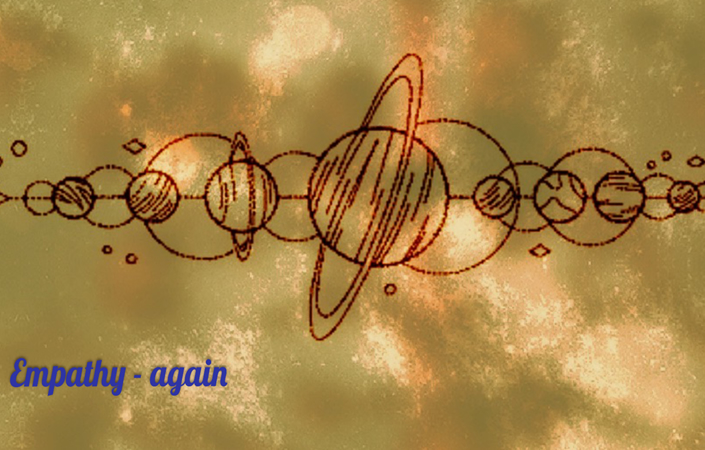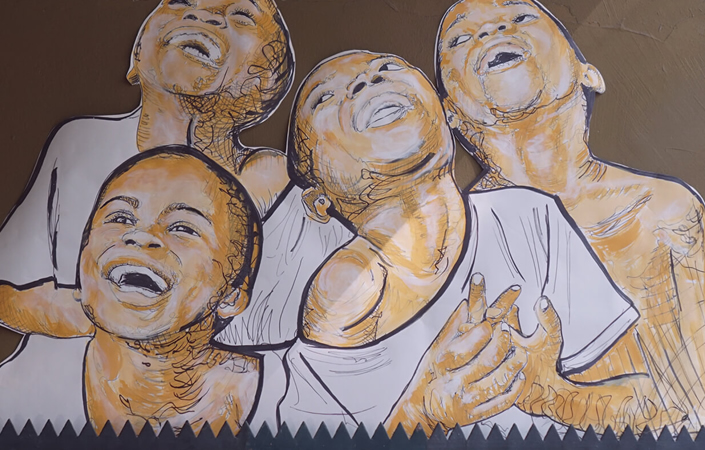4. February 2022

There is a lot of talk about empathy as a leadership trait. Empathy is thus primarily located in the process of communication between people. However, empathy has another, essential dimension, which also places it at the center of strategy development.
We are now increasingly and acceleratingly confronted with non-linear dynamics – be it in the markets, in the global political situation, in the needs of the customer groups relevant to us, in social developments, to name but a few. Our cognitive analytical tools for describing this reality and its future (even near future) developments are no longer sufficient for predicting and guiding in these dynamic non-linear systems prone to disruptive events. The high degree of interconnectedness with its upsurging, circling dynamics within our communication streams sets limits to dominantly rationally oriented strategy work.
As a necessary supplement, the ability to empathize is required not only of single individuals, but of social systems, be it companies, administrations, NGO’s, religious organizations, generally of all social systems. Empathy is here the ability to feel resonance patterns of our direct and indirect environment, in short we need the empathy ability of a collective. In addition to open internal communication and reducing value judgments, the empathic resonance capacity towards a dynamic environment can only succeed if the collective is diverse – encompassing all criteria of the diversity perspective, if possible.
Synnecta’s work with groups has always aimed at the development of collective empathic capacity and has been further strengthened in recent years around the open experience of always given diversity. However, the still large homogeneity of leadership groups sets a limit to the ability to resonate with non-linear dynamics and thus also narrows the strategy work.
Rüdiger Müngersdorff
9. November 2021

Throughout its long history, the Western world has returned time and again to the same demand: there must be a sense to your life, your existence must have a purpose that goes beyond the measure of life itself. Viktor Frankl has it that this can be something quite individual, but mostly, we are asking for something bigger, something that traverses a whole life. In national movements, for example, it has even gone as far as self-sacrifice. Children are already confronted with the need to declare a purpose in young years: »And what are you going to be one day?« Be useful! Fill your life with a task, a purpose. The message remains the same: What are you doing this for? What is the purpose? What is the sense? Life itself is not enough, it has to relate to something else, something greater.
As purpose concepts are gaining ground, they are pitching that demand right into the heart of businesses. They emphasize their claim: Pick a task, have a purpose! Choose an employer who also has a greater purpose. Be part of a community of sense. The core message is that a successful, fulfilled life must be borne by a purpose. Once you find yourself in your community of purpose, you will be motivated and engaged. That sounds good.
There is a flipside, though, which often leads to disappointment, fatigue, exhaustion, even a sense of failure. The need to have a purpose in life turns into an interior demand, an obligation. In other words: Justify yourself
The need for self-justification is one of our deepest individual and collectively shared beliefs. It calls upon a higher instance: a judge to whom we have to justify ourselves. In our individual lives, that role is often given to our parents. Casting a wider arch, it becomes increasingly unclear who will even pass that judgement.
What is it that we have to justify? First, we need to justify the sense, the purpose that we have given to our life or that has been given to us. Is my purpose a good and valuable purpose against an exterior measure? We ask that question of ourselves, but nowadays also of companies: does the business serve a good purpose, is it borne by a sense that transcends its mere task of being an economic success? This is the first step of justification. It leads to a second justification: Do I, do we fulfil our purpose? Once again, we are facing a judge and a jury. (Add to that the images of our culturally shaped background: it’s about heaven or hell.)
In my coaching work, I often encounter people who despair at this obligation and the expected judgement. They lose their joy in life and in existence against the backdrop of the judge’s ruling that they are foreseeing. When coaching addresses mindsets, it creates an awareness for these demands for a purpose. It also lets us experience which judges we effectively project in order to reinforce this life obligation.
A look at the role of CEOs reveals that the jury is cast so much more widely today. While justification used to be due only to the shareholders, it is now also owed to employees and to society. Those are quite differing scales.
The need to justify our life and our actions is surely an opposition to arbitrary selfishness. However, it can also dampen lively spontaneity, stop us from doing things for the sheer will to do so and obscure our own imagination as part of innovative action. Günther Anders posed a question that provides a fine reason to take a closer look at our own landscape of self-justification.
»Why do you suppose at all that a life might have to contain something else than just being, or even that it is possible for life to have such another thing – the very thing you call a purpose?«
(Günther Anders in Die Antiquiertheit des Menschen)
#myndleap #mindset #mindsetarbeit #mindsetcoaching #kollektivesmindset #synnecta #denksinnlich
Rüdiger Müngersdorff
This article was first published at www.myndleap.com
© Artwork: Mitra Art, Mitra Woodall
3. November 2021

Shifting the Meaning of Leadership Roles: Thinking Leadership from the Employee Perspective
1. How does the meaning come to be shifted?
The Western world has some specific cultural patterns. One of these calls out to us already from the Story of Creation in the Old Testament: »…replenish the earth, and subdue it!«, and it paints an expectation of pain and suffering. We are called upon to be doers, designers, movers. That is the core of the leadership role: design, do, create. Our modern experience of a global, networked world and its dynamics, as well as the confrontation with other cultural assumptions and values casts doubt on our notion of a confident, designing subject who has been given the world as a creative space. The modern experience appears different: it is not us who subdue the world, but the world that subdues, even overwhelms, us. Instead of scaring us off, though, this insight makes us look for new ways of finding a balance between designed influence and acceptance of the fact that the world shapes us as much as we shape it. It is an experience that also shapes our notion of leadership: the confident role taken on by a designing manager is being challenged by the potential of leadership by collectives.
We have reached a point where we are more likely to describe a manager as someone who enables, sponsors, moderates. We speak of serving managers with the values of humility and caring. It is the path from a strong ego to being part of a greater community.
It appears as if the manager of old had surrendered in the face of complexity, contingency and acceleration. That kind of leadership can no long fulfil the role of the knowledgeable designer and is facing the limits of its own confidence. Hence an answer is sought in the potentially more powerful and more intelligent collective and its multitude of voices. We trust in the wisdom of many views, different discourses and we believe that the collective as a group with a range of perspectives is more likely than the old manager-hero to succeed at the complex tasks of the modern world.
This development goes hand in hand with an insight that the Western dominant model that everything has a reason and can be based on a cause is powerful, but not universally applicable. A complex, accelerating and dynamic world teaches us to look at events in a systemic way: we view events as interactive and interwoven conditions in which we cannot find a single, unmistakeable cause, but instead find networks that might have caused the event we are seeking to explain. Knowing a single cause shows us a single goal-oriented path of action. A network of relationships forces us to follow feedback whatever we do, to become part of the network, to learn to live with the network. (Hence the altered understanding that mistakes, by triggering feedback, are an opportunity to learn.)
2. Has the old leadership role become obsolete with the turn towards the collective?
In order to master the challenges we face, to find an answer that serves the whole, we surely need the many voices of a diverse collective: we need open discourses without fear. For these discourses to be successful and the many voices not to get stuck in unforgiving positions, we also need guides, an orientation and the ties to a common horizon for whatever is needed at that point. It remains the leadership task to provide orientation, carrying the entire risk of having been wrong. Leadership must surely learn to accept that the subject is not the mighty centre but a part of the whole with a very specific role in that whole. It is always a painful task to learn that I am limited and restricted and that the path to overcoming that limitation are the others. There is another old adage that has accompanied the Western people, passed on by an Ancient Greek oracle: Remember, you are a human! Only a human, but also a human. Hannah Arendt attributed to these humans the ability to make a start. That also remains a leadership task.
3. Is the collective ready to assume leadership tasks?
In many years of working in group dynamic settings, I have seen how difficult it is to attain common orientation and goal-oriented cooperation in groups that lack leadership. In addition to the known group effects (finding roles, positions and meanings in a social field – emotionally driven effects), the development of collective, limiting patterns of perception, thinking and decision-taking form the greatest barrier to a multi-perspective and open dialogue. Together with the emotional dynamics of group cohesion, it reduces the opportunities of multiple perspectives, shrinking the group into – usually subconscious – groupthink. Without directed work on these limited patterns, groups stay far below their level and cannot achieve their given task: to better manage complexity. The dynamics of groups keep covering up the factual focus and, as psychoanalysis described for individuals, access to the collective mindset as a subconscious entity is boarded up by many defence mechanisms. This is why working with the collective mindset requires a deep expertise in group dynamics. It is the only way to manage the new balance in leadership: a more productive balance between leading and being led.
#myndleap #mindset #groupdynamic #collectivemindset #newleadership #synnecta #denksinnlich
Rüdiger Müngersdorff
This article was first published at www.myndleap.com
© Artwork: Mitra Art, Mitra Woodall
15. September 2021

Almost all companies have, now quite some time ago, dealt with their values, often writing them down and distributing them throughout the company. A significant source was often the memory of the founders’ »philosophy« and their words, often late words. The values formed the backbone of the organization and complemented the vision processes. Guiding this was a quote from Odo Marquard: »The future needs origins«. Today, they are a foundation of the »Purpose« processes. It is always about the answer to the question: Who are we and who and how do we want to be?
Now these values, which are often understood as temporally stable, even supratemporal, are actually values of an old world. And so the question arises: Do we need a new value process? And should it this time be designed less top down and more with the inclusion of the socio-ecological environment?
Values, shared, are all the more important the more autonomy and self-control an organization strives for. They are an indispensable part of indirect control, giving the relatively freely operating units a common foundation and thus increasing the possibility of expanding degrees of freedom and reducing hierarchical, direct control.
The importance of new, participatory value processes can be clearly seen in the topic of diversity. In an attempt to increase the diversity of a company, we are designing inclusion programs today, and although we want the difference, the background logic is often »to fit in«. The contradictory message is: be different, but please be within our culture. So we want a discrimination-free coexistence in the context of our culture, culture of origin. If we really want to be a global company and truly a common house for »diversity«, the old values will have to undergo an intensive revision. This must be done in such a way that diversity is not merely thought of and included, but in such a way that a common identity of differences is formed.
New values emerging from the diverse collective could give members of other life concepts, other cultural origins and other life stories the opportunity to find themselves reflected in the values of their company. Then it would also be justified to speak of global companies and not only of globally represented companies.
SYNNECTA has described a process with TheQuestBySynnecta, which can be an important guide here.
Rüdiger Müngersdorff
21. June 2021

The concept of mindset and tenets has proved useful in the coaching context. It effectively supports cognitive flexibility and brings coachees into contact with a wider range of tools to actively meet the challenges delivered in their life and work settings. It is good to see that many schools of mindset work are moving away from the normative concepts that hide behind such names as growth mindset and agile mindset. While those used to be and still are often sold to organizations, other phrases – like mindset plasticity and flexibility – make it apparent that what’s really at stake is an ability to react to situations rather than to loyally follow old scripts, as transactional analysis would put it. We are dealing with degrees of freedom and a credo that we know from the very roots of psychoanalysis: Awareness widens the range of possibilities – the possibilities to be able to react and act differently.
Despite this dynamic development in the mindset scene, the sales brochures continue to contain some blind spots – not everywhere, but still frequently enough. I have pointed out the roots of mindset in earlier articles (@myndleap @rüdigermüngersdorff @synnecta) and have sketched out a much wider basis for this approach. In the following I want to point out two aspects of mindset work that have not been fully tapped into.
Firstly, I keep coming across the phrase »emotionally charged belief sets«. As so often in Western culture, our fixation on cognitive structures and contents demotes emotions to secondary events that only serve to charge something. Psychotherapy has throughout its by now quite long history taught us at least that emotions are in fact dynamics in their own right that must be perceived and talked about as such. All research into the effectiveness of psychotherapy and coaching has shown that the most important effective factor is the relationship between the participants. This has to do not least with the fact that emotions are perceived and felt in the relationship between people. Great value can be ascribed here to the discovery of transference. These phenomena do not merely describe a misperception, but shape the very place where emotions take place before they can be translated into cognitive events or speech. The fixation on methods in most mindset schools dramatically underestimates this aspect of the work. In my projects in the Asian sphere I talk not only of mindset but also of heartset. This meets with great approval in those cultures and provides an approach to elevate emotional as well as cognitive flexibility. Repetition compulsion – the very opposite of flexible, appropriate perception and action – is not primarily tied to a structure of insight, evaluation and decision-making, but to an emotional reaction to the inner and outer context: a scene. This is where links are made and limits drawn, where beliefs attain the power of their message to guide actions. As long as we are unable to talk about the scenic feelings of fear, shame and guilt (qualities of transference and counter-transference), mindset work will not be able to deliver more than temporary patches.
In the face of the cognitive fixation and belief in methods that is inherent to many mindset schools, I keep returning to the same question: Who ever claimed that you think with your head rather than with your whole body? We cannot perceive our emotionality without encountering our physical side; as long as we do not experience the heartset, our mindset work cannot penetrate beyond the surface.
The second major fault of mindset discussions is their blindness for the conditions that are material to effective organizational development. While we are witnessing a cultural turn or a sociological turn in the cultural sciences, the soft consulting scene is experiencing the growth of a psychological approach. The statement that ‘I live my life’ holds as much truth as the claim that »My context lives me«. Prevailing resilience concepts call upon the individual to change, and the same is true in organizational development. This approach is based on the conviction that success will follow once all employees have developed a growth mindset, an agile mindset or a whatever mindset. There is a belief that this is the only path to changing our culture and supporting our organization goals. Practice shows, however, that this is an illusion. All organizations have a specific culture: their collective mind- and heartset, if you will. This culture is reproduced within the organization even when all its people are changed. (It is a deflating experience indeed to see a manager behaving so differently during training than in their company context.) In individual mindset work it seems to be apparent that beliefs are localized in the brain – although I would locate them in the body. In organizational development, we need to ask that old question about culture: where and how do we locate the consistent cultural patterns in organizations? Cultural sciences have a number of approaches to meet this question. These need to be integrated into organizational development. They are mostly relational and can hardly be captured with a classic thought pattern of cause and effect. It is about creating visibility for the web of relationships within which perception, decision-taking and action take place. As in individual work, the first step is awareness. These thoughts return the concept of mindset back to its origins: research into mentality in social classes and groups. It grasps how mindset work can help us understand the ties of collective behaviour, while at the same time opening a chance for emergence. Using Robert Musil’s words, we could say that working on the collective mindset means to add a sense of reality to a sense of possibility.
#myndleap #mindset #mindsetcoaching #organizationaldevelopement #synnecta #denksinnlich #collectivesmindset
This article was first published at www.myndleap.com
© Artwork: Mitra Art, Mitra Woodall





